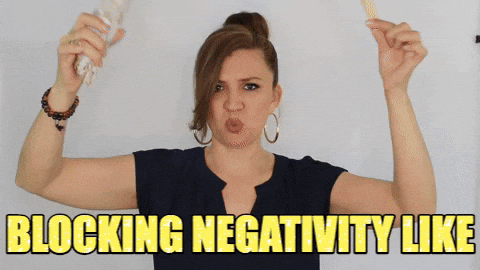Hypnotherapist's simple 'installation' trick gives negative people a more positive outlook
“My life completely changed and my mind was completely blown when I learned that it was possible.”

Thumbs up or thumbs down.
Emilie Leyes, a certified hypnotherapist and brain-training specialist, is helping people turn their negative outlooks more positive by teaching them a simple trick based on neuroscience. The trick is called “installation” and was developed by neuropsychologist Rick Hanson, Ph.D. Over time, it’s a simple practice that can reprogram our brains to counter our natural negativity bias.
Negativity bias refers to our proclivity to “attend to, learn from, and use negative information far more than positive information.” It’s why people tend to read negative headlines more than positive ones or are more likely to remember bad experiences than happy ones. It’s also why we have a larger emotional and physical response to adverse stimuli than things we enjoy.
Even though it’s an unpleasant trait, our focus on things that can harm us has helped humans survive for hundreds of thousands of years. However, according to Leyes, there’s a way to bring our minds into balance so that we don’t have such a negative, dour outlook on life.
How to have a positive outlook on life
“The good news is that you can actually counteract this negativity bias and change the way your brain functions. There's an amazing little tool, brain trick, whatever you want to call it, called installation,” Leyes said in a video with over 4 million views.
@emilieleyes.hypnosis Taking in more of the good experiences as they happen can keep our brains from thinking so negatively! If you want to be guided through this process and learn these tools in a way that lasts, make sure to check out my six week ✨hypnotic empowerment✨ masterclass where you will learn, bring training and Hypnosis tools to bring yourself out of this negativity, bias, reduce stress, build confidence, and believe in yourself as you pursue your goals! The session is from June 3 to July 8, And you can learn more and get registered at my⛓️ ##mentalhealth##mentalhealthawareness##selfcare##braintraining##neuroplasticity##positivity##mindset##mindsetshift##emilieleyes##psychology##psychologytricks##changeyourmindset##hypnosis##subconsciousmind
“It was developed by psychologist Dr. Rick Hansen, which is basically the act of, like, amplifying the positive experiences when they come. Because, remember, the positive experiences are less intense than the negative ones,” Leyes continued. “And the practice of installation is really all about savoring those positive moments longer and more intensely than you normally would.”
Leyes says you can use the technique whenever you have a positive experience. Let’s say you are enjoying a big, cheesy, saucy piece of pizza. As you come to the last bite, focus on all of the incredible flavors and slowly chew it. Savor every moment it’s in your mouth. “And in doing that, you're actually growing that emotional response to that positive experience, which over time can start to balance out that negativity bias,” she says.
Dr. Hanson says it’s ok if we create our own positive experiences by thinking about things we’re grateful for or remembering a time we stood up to a bully or had genuine compassion for someone in pain. “Then, once you’ve got that good experience going, really enjoy it: taking 5, 10, or more seconds to protect and stay with it, and open to it in your body. The longer and more intensely those neurons fire together, the more they’ll be wiring this inner strength into your brain,” Dr. Hanson writes.
The great thing is that the installation trick will not only improve your outlook but also open the door to more positive experiences.
“It's actually priming the brain to take in more good experiences as they come,” Leyes says in her TikTok video. “Cause what we put our focused attention on is amplified in our minds and totally informs our experience. So your brain will start to learn from that and start to recognize that positive experiences are equally important to the negative ones.”


